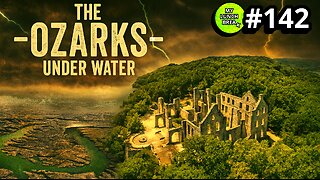Premium Only Content

Posnania in Poznan - SHOPS
Poznań (Polish: [ˈpɔznaɲ] ⓘ)[a] is a city on the River Warta in west-central Poland, within the Greater Poland region. The city is an important cultural and business centre, and one of Poland's most populous regions with many regional customs such as Saint John's Fair (Jarmark Świętojański), traditional Saint Martin's croissants and a local dialect. Among its most important heritage sites are the Renaissance Old Town, Town Hall and Gothic Cathedral.
Poznań is the fifth-largest and one of the oldest cities in Poland. As of 2023, the city's population is 540,146, while the Poznań metropolitan area (Metropolia Poznań) comprising Poznań County and several other communities is inhabited by over 1.029 million people.[2] It is one of four historical capitals of medieval Poland and the ancient capital of the Greater Poland region, currently the administrative capital of the province called Greater Poland Voivodeship.
Poznań is a centre of trade, sport, education, technology and tourism. It is an important academic site, with about 130,000 students and Adam Mickiewicz University, the third largest Polish university. The city serves as the seat of the oldest Polish diocese, now being one of the most populous Catholic archdioceses in the country. The city also hosts the Poznań International Fair, the biggest industrial fair in Poland and one of the largest fairs in Europe. The city's other renowned landmarks include the National Museum, Grand Theatre, Fara Church and the Imperial Castle.
Poznań is classified as a Gamma−global city by Globalization and World Cities Research Network.[6] According to several rankings it is one of the most business-friendly cities in Poland.[7] It also ranks highly in safety and healthcare quality.[8] The city of Poznań has also, many times, won the prize awarded by "Superbrands" for a very high quality city brand. In 2012, the Poznań's Art and Business Centre "Stary Browar" won a competition organised by National Geographic Traveler and was given the first prize as one of the seven "New Polish Wonders". Companies headquartered in the city include energy provider Enea and e-commerce company Allegro.
The official patron saints of Poznań are Saint Peter and Paul of Tarsus, the patrons of the cathedral. Martin of Tours – the patron of the main street Święty Marcin – is also regarded as one of the patron saints of the city.
Names
See also: Names of Poznań in different languages
The name Poznań probably comes from a personal name Poznan, which was in turn derived from the Polish participle poznan(y) – "one who is known/recognized", and would mean "Poznan's town". It is also possible that the name comes directly from the verb poznać, which means "to get to know" or "to recognize", so it may simply mean "known town".
14th-century seal showing Poznań's coat of arms.
The earliest surviving references to the city are found in the chronicles of Thietmar of Merseburg written between 1012 and 1018: episcopus Posnaniensis ("bishop of Poznań", in an entry for 970) and ab urbe Posnani ("from the city of Poznań", for 1005). The city's name appears in documents in the Latin nominative case as Posnania in 1236 and Poznania in 1247. The phrase in Poznan appears in 1146 and 1244.
The city's full official name is Stołeczne Miasto Poznań (The Capital City of Poznań), in reference to its role as a centre of political power in the early Polish state under the Piast dynasty. Poznań is known as Posen in German, and was officially called Haupt- und Residenzstadt Posen (Capital and Residence City of Poznań) between 20 August 1910 and 28 November 1918. The Latin names of the city are Posnania and Civitas Posnaniensis. Its Yiddish name is פּױזן, or Poyzn.
In Polish, the city's name has masculine grammatical gender.
Special Thanks:
Harold Perrineau & Wes Craven & Peyo & Morton & Jack Palance & Bjork & Joseph Murphy & Derren Brown & Jess Harnell & Charles Aznavour & Porfiry Iwanow & Ben Watkins & Kmyle & Sonia Choquette & R. Kelly & Donald Trump & Doug Wead & Brad Pitt & Robert De Niro & Ryan Gosling & Tim Freke & Chazz Palminteri & Nolan North & Sam Harris & Eddie Murphy & Harry Gaze & Ralph Waldo Emerson & KC
The first settlements in what is now Poznań can be traced to the late period of the Stone Age. Later various cultures developed there in the Bronze Age and Iron Age.
Poznań began as a stronghold built in the 8th or 9th century AD between branches of the Warta and Cybina rivers, on what is now called Ostrów Tumski ("Cathedral Island"). Various other settlements sprang up nearby on the islands and on both banks of the Warta. In the 10th century the tribe inhabiting the region, the Polans, became dominant over other tribes in most of the area of today's Poland. Consequently, this early Polish state, ruled by Duke Mieszko I and his successors in the Piast dynasty, was centred politically on Poznań and the neighbouring Polan strongholds, particularly Gniezno and Giecz. Archaeological research shows that in the late 10th century Poznań had a ducal palace (where the Church of Our Lady now stands, opposite the cathedral), with a chapel, possibly built for Mieszko's Christian wife Dobrawa. The ceremony by which Mieszko converted to Christianity in 966, known as the Baptism of Poland, is likely to have taken place at Poznań.
Following the conversion, in 968 Poland received its first missionary bishop, Jordan, who is believed to have used Poznań as his seat. Construction began of Poznań's cathedral. This was originally built in an early Romanesque style, and as Poland's first cathedral had St. Peter as its patron. The first rulers of Piast Poland – Mieszko I, Bolesław I and Mieszko II – are buried beneath the cathedral.
Gniezno was created an archbishopric at the Congress of Gniezno in 1000, by agreement between Bolesław I and Holy Roman Emperor Otto III. However Jordan's successor Unger remained as Bishop of Poznań independent of Gniezno, although it is not clear whether this continued to be a missionary bishopric subordinate to the Pope, or was attached to the Bishopric of Magdeburg.
With Mieszko II's death in 1034, which probably occurred in Poznań (and may have been the result of an aristocratic plot), the country entered a period of anarchy and pagan reaction, which caused much devastation in the region. In 1038 Bretislaus I, Duke of Bohemia invaded, sacking and destroying Poznań and Gniezno. When Poland's unity was restored by Casimir the Restorer in 1039, the capital was moved to Kraków, which had been relatively undamaged by the troubles. Poznań and Gniezno were rebuilt, and in spite of the decline in the region's political importance, Poznań remained an important economic center.
-
 LIVE
LIVE
SpartakusLIVE
4 hours agoVerdansk Duos w/ Nicky || Saturday Spartoons - Variety Later?!
296 watching -
 LIVE
LIVE
Mally_Mouse
1 day ago🔥🍺Spicy HYDRATE Saturday!🍺🔥-- Let's Play: Grounded
162 watching -
 LIVE
LIVE
Patriots With Grit
3 hours ago"HELP... They're Killing Me" | Gail Seiler
65 watching -
 3:07:51
3:07:51
Barry Cunningham
6 hours agoPRESIDENT TRUMP ANNOUNCES THE CHIPOCALYPSE! AND I'M HERE FOR IT! (AND MORE NEWS)
116K42 -
 13:37
13:37
Exploring With Nug
9 hours ago $1.88 earnedTrying to Uncover Secrets in St Augustine’s Waters Missing Person Search!
13K1 -
 24:09
24:09
MYLUNCHBREAK CHANNEL PAGE
1 day agoDams Destroyed The Ozarks
68.1K32 -
 1:32:54
1:32:54
Jeff Ahern
6 hours ago $26.09 earnedThe Saturday Show with Jeff Ahern
90.2K10 -
 8:50:24
8:50:24
TheManaLord Plays
8 hours agoMANA SUMMIT - DAY 1 ($10,200+) | BANNED PLAYER SMASH MELEE INVITATIONAL
54K3 -
 LIVE
LIVE
Major League Fishing
3 days agoLIVE Tackle Warehouse Invitationals Championship, Day 2
97 watching -
 LIVE
LIVE
CassaiyanGaming
9 hours agoMYSTIVITHON - 12 HOUR CHARITY STREAM 🌊
61 watching